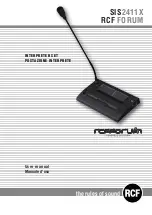
USER MANUAL BATMODE 2S/2S+ SYSTEM
51
These settings do not affect the recording of the temperature and precipitation values, which is
automatically started with the monitoring and always stores in a 10-minute interval the mean values
of the data determined every 30 seconds (exclusively BATmode 2S+).
Figure 32: Relative Monitoring periods
4.2.3.2
Test of Microphone Sensitivity (<Daily Testsignal> - Box)
To ensure a correct acoustic bat monitoring, which records all bat calls of a maximum pressure level
greater than the previously in the calibration (see section 4.2.3.4) defined trigger level ("Level of
Trigger Threshold"), an ultrasound signal generator is integrated in the microphone disc. It generates
a defined ultrasound signal with known sound pressure level, which allows the monitoring of the
microphone sensitivity. By this, the validity of the acoustic monitoring can be verified.
In order to determine microphone sensitivity, the ultrasonic signal generator is activated by the
RECORDER software for one minute and generates a temporally varying narrow-band ultrasound signal
between 30 and 50 kHz. By this, temperature-dependent influences on the resonance frequency of
the ultrasound signal generator are compensated. With the automatically opened "Trigger Level
Calibration" dialogue, the software RECORDER measures the maximum signal level relative to the
maximum output value of the microphone in dBFS (dB Full Scale), continuously (see Figure 33). Finally,
the maximum measured value is stored in the file "reference.txt" in the monitoring directory.
A fictitiously assumed value of -13.6 dBFS means that the maximum sound pressure level of the test
signal generator determined during the measurement is -13.6 dB below the maximum output value of
the microphone. If the value is within a range of ± 6 dB around the "Full Scale Level of Reference Signal"
specified in the calibration certificate, bat monitoring will provide correct data.
If smaller negative values are determined (for example -10 dBFS) than specified in the calibration
certificate, the test signal generated by the ultrasonic signal generator is recorded "too loud" by the
microphone. This indicates that there are sound reflecting objects in front of the microphone. If, on
the contrary, larger negative values are determined (for example -25 dBFS), the test signal is recorded
as "too quiet". This is mostly due to dirt, aging or a defect of the microphone.















































